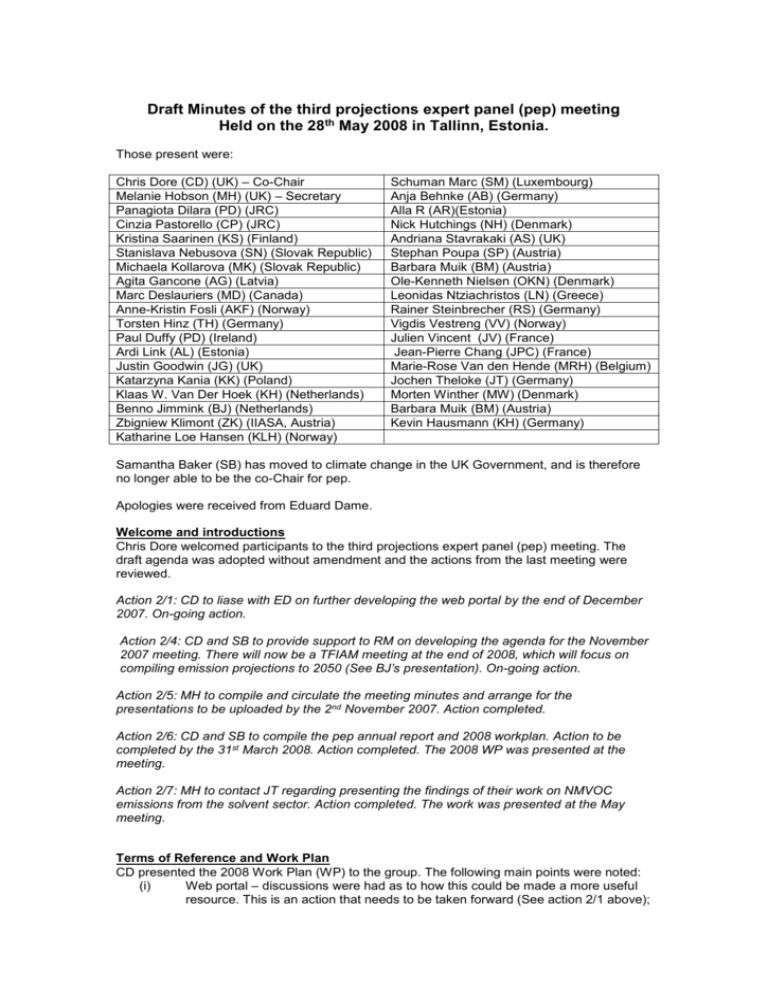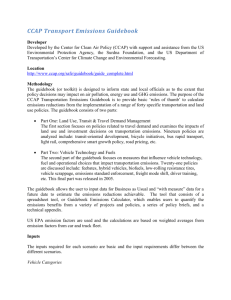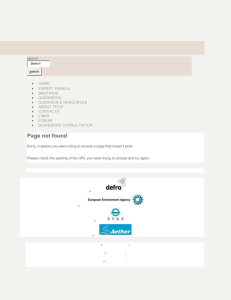Notes for the first PEP meeting – 25th May 2007, Dessau, Germany
advertisement

Draft Minutes of the third projections expert panel (pep) meeting Held on the 28th May 2008 in Tallinn, Estonia. Those present were: Chris Dore (CD) (UK) – Co-Chair Melanie Hobson (MH) (UK) – Secretary Panagiota Dilara (PD) (JRC) Cinzia Pastorello (CP) (JRC) Kristina Saarinen (KS) (Finland) Stanislava Nebusova (SN) (Slovak Republic) Michaela Kollarova (MK) (Slovak Republic) Agita Gancone (AG) (Latvia) Marc Deslauriers (MD) (Canada) Anne-Kristin Fosli (AKF) (Norway) Torsten Hinz (TH) (Germany) Paul Duffy (PD) (Ireland) Ardi Link (AL) (Estonia) Justin Goodwin (JG) (UK) Katarzyna Kania (KK) (Poland) Klaas W. Van Der Hoek (KH) (Netherlands) Benno Jimmink (BJ) (Netherlands) Zbigniew Klimont (ZK) (IIASA, Austria) Katharine Loe Hansen (KLH) (Norway) Schuman Marc (SM) (Luxembourg) Anja Behnke (AB) (Germany) Alla R (AR)(Estonia) Nick Hutchings (NH) (Denmark) Andriana Stavrakaki (AS) (UK) Stephan Poupa (SP) (Austria) Barbara Muik (BM) (Austria) Ole-Kenneth Nielsen (OKN) (Denmark) Leonidas Ntziachristos (LN) (Greece) Rainer Steinbrecher (RS) (Germany) Vigdis Vestreng (VV) (Norway) Julien Vincent (JV) (France) Jean-Pierre Chang (JPC) (France) Marie-Rose Van den Hende (MRH) (Belgium) Jochen Theloke (JT) (Germany) Morten Winther (MW) (Denmark) Barbara Muik (BM) (Austria) Kevin Hausmann (KH) (Germany) Samantha Baker (SB) has moved to climate change in the UK Government, and is therefore no longer able to be the co-Chair for pep. Apologies were received from Eduard Dame. Welcome and introductions Chris Dore welcomed participants to the third projections expert panel (pep) meeting. The draft agenda was adopted without amendment and the actions from the last meeting were reviewed. Action 2/1: CD to liase with ED on further developing the web portal by the end of December 2007. On-going action. Action 2/4: CD and SB to provide support to RM on developing the agenda for the November 2007 meeting. There will now be a TFIAM meeting at the end of 2008, which will focus on compiling emission projections to 2050 (See BJ’s presentation). On-going action. Action 2/5: MH to compile and circulate the meeting minutes and arrange for the presentations to be uploaded by the 2nd November 2007. Action completed. Action 2/6: CD and SB to compile the pep annual report and 2008 workplan. Action to be completed by the 31st March 2008. Action completed. The 2008 WP was presented at the meeting. Action 2/7: MH to contact JT regarding presenting the findings of their work on NMVOC emissions from the solvent sector. Action completed. The work was presented at the May meeting. Terms of Reference and Work Plan CD presented the 2008 Work Plan (WP) to the group. The following main points were noted: (i) Web portal – discussions were had as to how this could be made a more useful resource. This is an action that needs to be taken forward (See action 2/1 above); (ii) (iii) The need to review the Co-chair positions. If there are any volunteers for this position, then please let CD or MH know by the 30th June; The contribution that had been made by parties to the Guidebook update process The following action arose from these discussions: Action 3/1: All parties to consider whether they would like to volunteer for a co-chair position on the pep. Expert panel feedback The following main points were noted from the discussion: Agriculture & nature: The panel is mainly concentrating on the guidebook work at the moment. Last week NH attended the Task Force on reactive nitrogen. For further information see: www.clrtap-tfrn.org/ (NH) RS gave a presentation on the NatAir project. Further information is available from http://natair.ier.uni-stuttgart.de/ The project aims to improve methods for estimating emissions from natural sources and all relevant substances are covered. Examples of sectors that are covered are: - NO from soils - CH4 and NH3 from wild animals - PM from wind blown dust, and - NOx from lightning. These are all sources that are not required to be reported but are required by modellers. RS showed some maps of natural NMVOC emissions across Europe and stressed the importance of natural NMVOCs in ozone production across Europe. The incorporation of the Natair results will go in to the maintenance plan of the guidebook as there aren’t any resources at the moment to incorporate the new data. At present just the text in the old guidebook will be copied across to the new version. Transport The panel have reviewed the guidebook chapters relating to transport and are generally happy with them but a few things still need to be resolved. (LN) Industry The panel still have some issues with the guidebook and the combustion chapters. These will need to be resolved over the next couple of weeks. (OKN) Projections The main issue still arising with the projections chapter is that it refers to the sector chapters, but at present there is no text in the sector chapters on the projections. This comment has been passed to the Guidebook contractors. (CD) Presentation by JT on NMVOC emissions from the solvent sector in Germany The following main point were noted: Emissions from the solvent sector are the largest source of NMVOC emissions in Germany. For emission calculations, you need import and export amounts of solvent but this data is often confidential. Production statistics in combination with foreign trade statistics are therefore used. An example of estimating emissions from the paint application sector was given. The project has produced various emission projection scenarios. These include (1) using constant emission factors and (2) a reference scenario. 97% of printing installations in Germany are not covered by the solvent directive. It has been assumed that the Solvent Directive has been fully implemented. The projections have been based on economic indicators and estimated impacts of current legislation. In response to this point ZK suggested that it is not only economic drivers that will influence future activity levels – eg. paints are becoming more robust and last longer meaning that you don’t have to paint your house so often… In Germany, data is available on the split between those installations covered by the Solvent Directive and those not, but other countries don’t have access to this information and this makes it difficult for IIASA to know what to assume in the GAINS model. Presentation by BJ – dutch treat or dutch bargain? The following main points were noted: Emissions of NOx and SO2 are declining but it is still uncertain whether the Netherlands will meet the ceilings for these pollutants. The Netherlands are likely to meet the NMVOC and NH3 targets. Various current policies & measures in the pipeline were presented. TFIAM’s intention to host a workshop on compiling scenarios for 2050 was also discussed – see below. 2050 workshop The Executive Body of the Convention on Long-Range Transboundary Air Pollution, has requested that various bodies under the Convention develop an ‘aspirational’ scenario for 2050. The Task Force on Integrated Assessment Modelling is seeking co-operation with other groups such as the Working Group on Effects, the Expert Group on Techno-Economic Issues (EGTEI) and the Projections Expert Panel of TFEIP and would like to know whether national experts are available who could share experiences on longer term scenario building and ‘backcasting’ the necessary steps (in terms of technological development and behaviour change) in view of meeting a target (e.g. meeting critical loads and levels) in 2050. TFIAM is planning a small scale ‘2050-workshop’ at the end of this year (or the beginning of 2009) with experts (40 max) that are willing to contribute to a paper to be published in spring 2009. The following action arose from the discussions: Action 3/2: All pep members are urged to contact Rob Maas (rob.maas@mnp.nl) if they are interested in being involved in the 2050 workshop. Presentation by ZK on EC4MACS (European Consortium for modelling of air pollution and climate strategies) The following main points were noted: An overview was given of the background, work plan, recent achievements and next steps in the project. The EC envisages a review in 2011/12 of air quality legislation and the European Climate Change programme. Model analyses can make useful contributions. 2007 focused on methodology improvements. 2008 is focusing on data collection and feedback on methodological improvements. It is likely that in 2010 there will be a projections workshop. GAINS – numerous scenarios have been exchanged for the Commission’s burden sharing proposal. There is now new documentation on GAINS showing the link between Snap codes and NRF and the GAINS codes. EuroCare – updated to include the western Balkans and Turkey. Improved description of the N cycle inherited from earlier projects. PRIMES – number of updates. The potential of CCS is now included. Liaison with countries has improved the data. Final baseline was produced in November 2007 but there is also an energy & climate scenario that was produced in Jan2008. Tasks for 2008 – produce interim documentation on methodologies, harmonise C/N cycle and agricultural modelling approaches Presentation by ZK on the status of the revised NEC Directive The following main points were noted: Comm’s agreement planned for July 2008. There is no final decision yet but NEC proposal will be consistent with climate and energy package in terms of energy projections. Economic development and energy policy will be as in PRIMES November 2007 baseline. There will be no further stakeholder involvement before the publication of the final commission’s proposal Once agreed, NEC6 report will be available. The cost burden (% of GDP) varies a lot across countries. A sensitivity case was undertaken without the climate and energy package (ie using the November baseline). It suggests robustness against (reasonable) changes in major exogenous policy assumptions. Documentation will be released after publication of the final commission proposal. Presentation by AS on shipping The following main points were noted: Entec have undertaken various projects on shipping emissions. These include a project for the EC, CONCAWE and currently one for Defra looking at shipping emissions in UK waters. The objectives and overall approach was presented. Further detail can be found in the presentation Vessel movement data provided by the LMU register & AIS. Vessel characteristics and engine characteristics are provided. Timetables – time in port, time of arrival and departure are also available. Efs were developed by IVL originally. Provide data by engine size category. Presentation by AB on biomass The following main points were noted: Study looked at the determination of average Efs for the current and future development of small combustion plant in e.g. households. The aim of the study was to improve data for reporting obligations. The study took into account the different fuel types and type of installations – woodchip boilers, pellet boilers, open fire stoves, slow combustion stoves etc… Sources of info: Household surveys on wood consumption, data from chimney sweeps etc., Emission factors – literature analysis, emission measurements, and field investigations. The study has shown that NOx and PAH emissions are potentially high from wood combustion Study looked at projections too. A WoM and WAM scenario has been assessed. The WAM scenario includes regulations for new and old small combustion installations. Despite increases in wood combustion, emissions are predicted to decline in the future as a result of regulations. At present there are no plans to include the results of this study in the Guidebook. This is mainly due to the fact that the study has not yet been published. Any other business Other recent meetings of interest: Remote sensing and emissions meeting. Meeting held at IIASA, December 2007. http://www.iiasa.ac.at/rains/meetings/ACCENT_satellite/accent_satellite.html A discussion on near term strategies for slowing warming in the artic: short lived pollutants and artic warming. Copenhagen, Denmark. May 8-9, 2008. http://www.catf.us/projects/climate/international_climate/ On Monday and Tuesday (26th & 27th May) there was a GHG projections meeting in Brussels. Several very useful presentations can be found at: http://wwwb.vito.be/ghgprojection/ Suggested ideas for presentations at November 2008 meeting: Consistency between NEC reporting and MM reporting. Quantification of costs related with measures. Guidebook maintenance plan NEC review – comparison of NEC2 proposal with Countries new forecasts. Overview of how activity projections are developed How the activity forecasts are incorporated in to the GAINS model. Next meeting It is anticipated that the next projections expert panel meeting will be held on November 10 th and 11th 2008 in Milan during the main TFEIP meeting.







